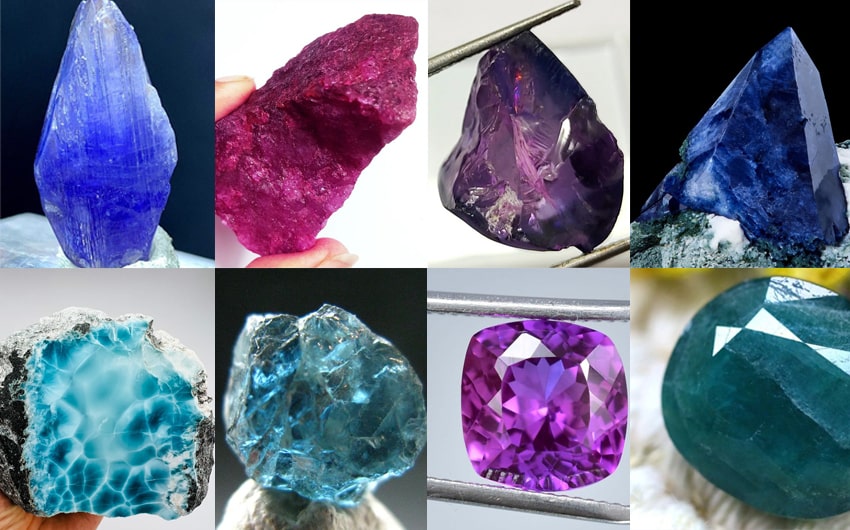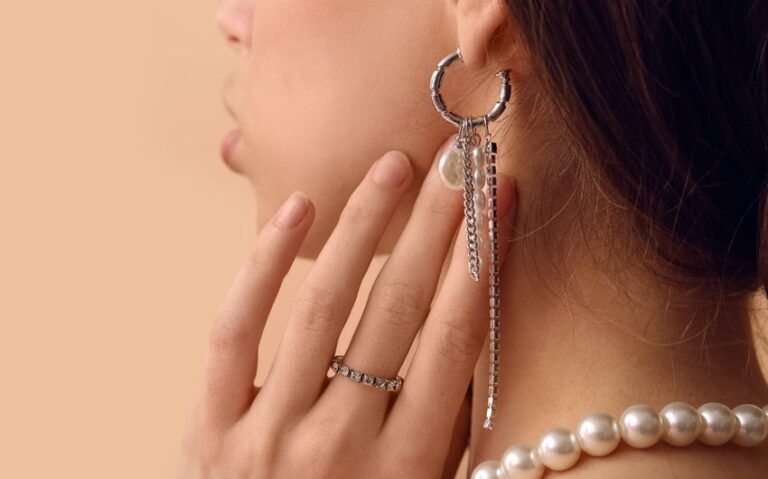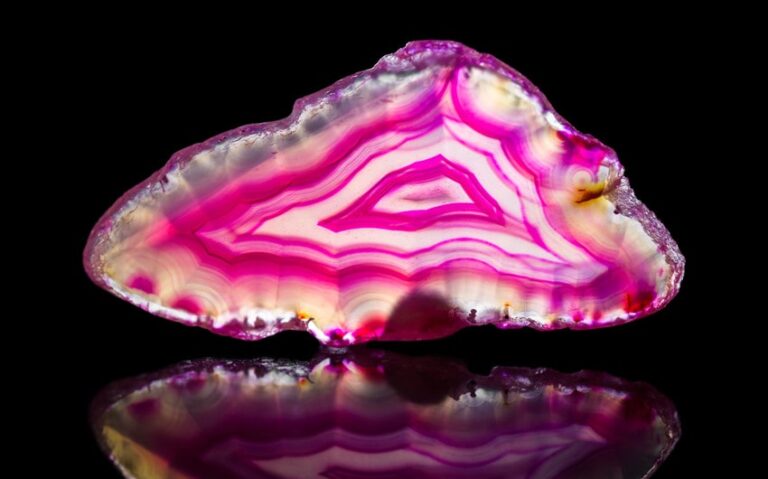The Most Beautiful 12 Rare Crystals Found Around the World
There’s something undeniably captivating about rare crystals. Whether you’re a collector, a lover of nature’s beauty, or simply fascinated by unique gemstones, rare crystals offer a world of wonder. These stunning natural creations, formed over millions of years, are not only beautiful but also incredibly hard to find. Their rarity makes them highly sought after by enthusiasts and collectors alike.
In this article, we’ll explore some of the most extraordinary rare crystals in the world, delving into what makes each one so special.
12 Rare Crystals You Need to Know
1. Painite: One of the Rarest Crystals in the World
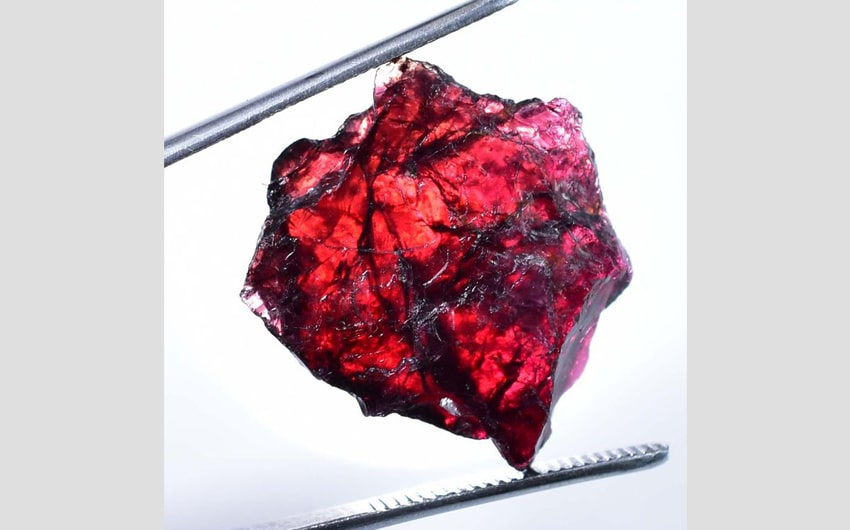
Image source: pinterest
Painite is often regarded as one of the rarest and most elusive crystals on Earth, earning its place as a prized gem among collectors. Discovered in Myanmar in the 1950s by British mineralogist Arthur C.D. Pain, after whom it was named, this crystal remained a true mystery for decades due to its extreme rarity. For a long time, only a handful of Painite specimens were known to exist, making it one of the rarest minerals ever documented.
What Makes Painite So Rare?
Several factors contribute to the rarity of Painite. First, its formation requires a unique combination of conditions that are not common in most of the Earth’s crust. Painite is primarily composed of calcium, zirconium, boron, aluminum, and oxygen, but the exact geological process that creates this crystal is rare. Additionally, Painite is found in only a few small locations, primarily in Myanmar, where the majority of specimens have been unearthed.
Initially, after its discovery, there were only two confirmed Painite crystals in existence, both held in museums. This extreme scarcity made Painite nearly unattainable for even the most dedicated gem collectors. However, in more recent years, more Painite crystals have been discovered in Myanmar, but it remains one of the rarest and most valuable gemstones in the world.
Physical Characteristics of Painite
Painite crystals are typically a deep reddish-brown, though they can sometimes exhibit hues of orange or pink under certain lighting conditions. The crystal has a hexagonal structure and is known for its impressive hardness, ranking 8 on the Mohs hardness scale, making it relatively durable compared to other gemstones.
Despite its rich, deep color, Painite is not widely used in jewelry due to its rarity and high value. Most Painite crystals are found in their raw, natural form and are kept as part of private or museum collections rather than being cut into gemstones for wear. However, when Painite is cut and polished, its deep brownish-red hue with occasional flashes of orange can be truly breathtaking.
Value of Painite
Because of its extreme rarity, Painite is considered one of the most valuable crystals in the world. Prices for Painite can vary significantly depending on the size and quality of the specimen, but it is not uncommon for high-quality Painite crystals to fetch several thousands of dollars per carat. For collectors, owning a piece of Painite is akin to owning a piece of geological history—one of the rarest and most precious gems ever discovered.
Spiritual and Healing Properties
Though Painite is more renowned for its rarity than its metaphysical properties, some crystal enthusiasts attribute spiritual significance to it. Painite is believed to help align the body’s energy fields and aid in personal transformation. It’s said to bring a sense of clarity, helping individuals to see the bigger picture in life and make more grounded decisions. As with many crystals, the rarity of Painite adds to its allure in spiritual communities, making it a prized possession for those who practice crystal healing.
2. Tanzanite: The Rare Gem Found Only in Tanzania
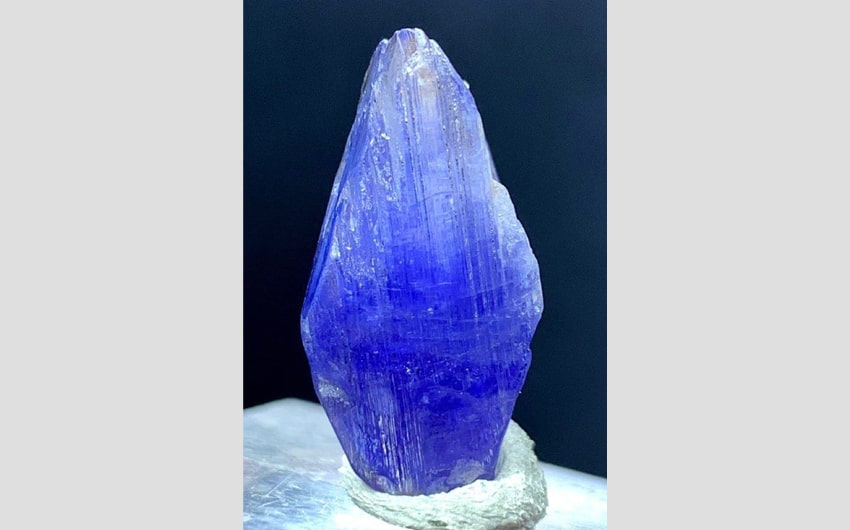
Image source: pinterest
Tanzanite is a gemstone that has captivated collectors and jewelry enthusiasts alike with its stunning blue-violet hues and remarkable rarity. Discovered in 1967 by a Maasai tribesman near Mount Kilimanjaro in Tanzania, this gem was soon introduced to the world by Tiffany & Co., who gave it the name “Tanzanite” after its country of origin. What makes Tanzanite particularly special is that it is found only in one small area of the world, specifically a 14-square-kilometer area near Mount Kilimanjaro, making it a true geological marvel.
What Makes Tanzanite So Rare?
The rarity of Tanzanite stems from its highly limited geographical source. The only known deposit of Tanzanite is located in the Merelani Hills of northern Tanzania. Once this supply is exhausted, there will be no new sources for this gemstone, which makes it highly sought after. The gemstone is considered rarer than diamonds due to its singular location and relatively recent discovery.
Another factor that contributes to its rarity is that Tanzanite is the blue variety of the mineral zoisite, and its blue-violet color is achieved through a natural heating process. Some Tanzanite crystals require heat treatment to enhance their blue and violet hues, which adds to the value and allure of the gemstone.
Physical Characteristics of Tanzanite
Tanzanite’s color can range from rich blue to deep violet, depending on the angle at which it is viewed. This unique color-changing property is known as pleochroism, where the gemstone appears to shift colors based on the angle of light. Tanzanite typically ranks between 6 and 7 on the Mohs hardness scale, which means it is suitable for jewelry but should be handled with care to prevent scratches or damage.
When cut and polished, Tanzanite’s deep, vibrant hues make it one of the most beautiful and desirable gemstones in the world. It is commonly used in fine jewelry, from rings to necklaces, and is particularly popular for engagement rings due to its unique coloring and rarity.
Value of Tanzanite
Tanzanite is considered a highly valuable gemstone, with prices ranging depending on the quality, size, and color intensity of the stone. The deeper the blue or violet, the more valuable the Tanzanite. In recent years, the scarcity of Tanzanite has driven its price up, making it a prized possession for collectors and investors alike.
Spiritual and Healing Properties
In metaphysical practices, Tanzanite is believed to help with communication, intuition, and spiritual growth. Its calming blue-violet energy is thought to aid in deepening meditation and connecting with higher consciousness. For many, Tanzanite is also associated with transformation, aiding those who seek personal and spiritual growth.
3. Red Beryl: The Scarlet Emerald

Image source: pinterest
Red Beryl, also known as “bixbite” or “scarlet emerald,” is one of the rarest and most valuable gemstones in the world. Unlike other beryl family gems like emeralds, Red Beryl is found in very few places, making it exceedingly rare and coveted by collectors. Discovered in the Wah Wah Mountains of Utah, USA, Red Beryl’s vibrant red color and limited supply have made it one of the most expensive gems per carat.
What Makes Red Beryl So Rare?
Red Beryl’s rarity is due to the specific geological conditions required for its formation. It is only found in a handful of locations, most notably in the Wah Wah Mountains of Utah. For Red Beryl to form, high levels of beryllium must be present, along with manganese, aluminum, and silica under the right temperature and pressure conditions. These specific requirements are why Red Beryl is so rare and why its deposits are limited to such small areas.
Physical Characteristics of Red Beryl
Red Beryl has a vibrant, rich red color, often compared to rubies, but with its own unique hue. It typically ranks 7.5 to 8 on the Mohs hardness scale, making it durable enough for jewelry. However, due to its rarity and high cost, Red Beryl is more commonly collected as a specimen rather than worn in jewelry.
The gem’s red color comes from trace amounts of manganese, and its intensity can vary based on the specific mineral composition. When found in gem-quality form, Red Beryl is breathtakingly beautiful and extraordinarily valuable.
Value of Red Beryl
Red Beryl is considered one of the rarest and most expensive gemstones in the world, often valued at tens of thousands of dollars per carat. Due to the scarcity of gem-quality specimens, it is highly prized by collectors, and even small Red Beryl crystals can fetch significant prices.
Spiritual and Healing Properties
Spiritually, Red Beryl is thought to stimulate vitality, courage, and passion. It is believed to help with emotional healing and to inspire love and positive energy. Red Beryl’s rarity and intense color add to its perceived metaphysical power, making it a sought-after gem for those practicing crystal healing.
4. Alexandrite: The Color-Changing Gemstone
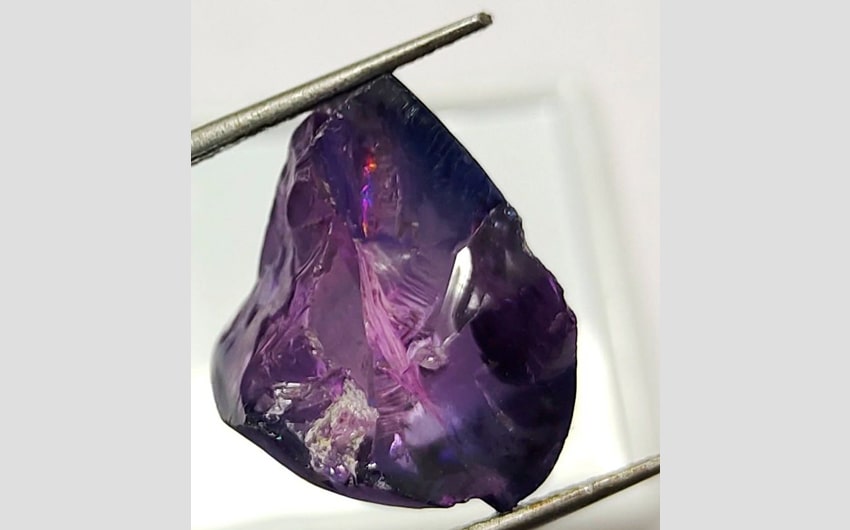
Image source: pinterest
Alexandrite is one of the most unique and fascinating gemstones due to its ability to change color depending on the light. Discovered in Russia’s Ural Mountains in the 1830s, Alexandrite is a variety of the mineral chrysoberyl. It is famous for its dramatic color change—from green in daylight to red under incandescent light—making it one of the most prized gemstones in the world.
What Makes Alexandrite So Rare?
The rarity of Alexandrite lies in its unique chemical composition and the very specific conditions required for its formation. Alexandrite contains trace amounts of chromium, which causes the color-changing phenomenon. Its original discovery in the Ural Mountains provided high-quality Alexandrite, but these deposits have largely been exhausted, and new sources in Brazil and Sri Lanka are more limited.
Because high-quality Alexandrite that exhibits a strong color change is so rare, it is one of the most valuable gemstones on the market today.
Physical Characteristics of Alexandrite
Alexandrite’s most famous characteristic is its ability to change color. In daylight, it appears green to bluish-green, while under incandescent light, it shifts to red or purplish-red. This optical property, known as the “Alexandrite effect,” is what makes the gem so special.
Alexandrite ranks 8.5 on the Mohs hardness scale, making it a durable gemstone suitable for everyday wear in jewelry. Its color-changing ability and relative hardness make it highly desirable for high-end jewelry pieces.
Value of Alexandrite
The value of Alexandrite depends largely on the strength of its color change and the clarity of the stone. Stones with a pronounced color change from green to red are considered the most valuable. Due to its rarity, Alexandrite can command prices of up to $70,000 per carat, particularly for stones from the original Russian deposits.
Spiritual and Healing Properties
Alexandrite is associated with balance, creativity, and self-confidence. Its color-changing properties symbolize adaptability and transformation, making it a powerful stone for those seeking to embrace change in their lives. It is also said to bring good fortune and joy to those who wear it.
5. Jeremejevite: The Rare and Striking Gemstone
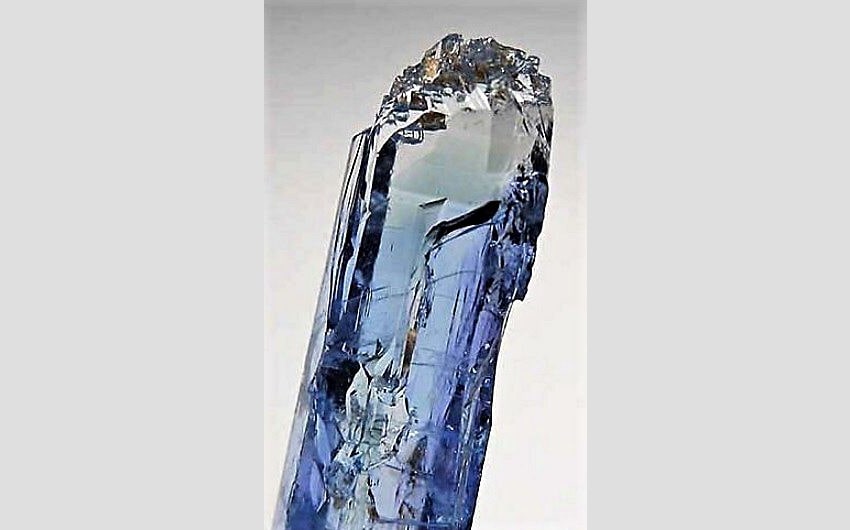
Image source: pinterest
Jeremejevite is one of the world’s rarest and most beautiful gemstones, known for its striking blue hues. First discovered in Siberia in 1883, it was named after the Russian mineralogist Pavel Jeremejev. Today, gem-quality Jeremejevite is found in only a few locations around the world, making it a highly sought-after stone among collectors.
What Makes Jeremejevite So Rare?
Jeremejevite is rare because it forms under very specific geological conditions and in only a few places. Most gem-quality Jeremejevite comes from Namibia, though small deposits have been found in Madagascar and Myanmar. Its scarcity and stunning blue color make it a gemstone that is highly valued by collectors.
Physical Characteristics of Jeremejevite
Jeremejevite typically appears in shades of light to deep blue, although it can also be colorless or yellowish in some cases. It has a hardness of 6.5 to 7.5 on the Mohs scale, making it relatively durable but still requiring care when used in jewelry.
The beauty of Jeremejevite lies in its transparency and vibrant color, which can rival the finest aquamarine. It is most commonly found as small crystals, and larger specimens are exceedingly rare.
Value of Jeremejevite
Due to its rarity, Jeremejevite can be quite valuable, especially when found in gem-quality form. Prices vary based on the size and quality of the stone, with fine blue Jeremejevite gemstones commanding high prices in the collector’s market.
Spiritual and Healing Properties
In crystal healing, Jeremejevite is believed to promote clarity of mind and enhance spiritual awareness. It is said to help with communication and is thought to bring a sense of calm and peace to those who carry or wear it.
6. Benitoite: California’s Rare Blue Gem

Image source: pinterest
Benitoite is a rare blue barium titanium silicate gemstone, highly sought after for its stunning color and rarity. It was first discovered in 1907 near the San Benito River in California, from which it takes its name. Benitoite’s unique blue glow under UV light and its scarcity make it one of the most prized gems for collectors and gemologists alike. In 1985, Benitoite was designated as the official state gemstone of California, further cementing its place as a treasured mineral.
What Makes Benitoite So Rare?
Benitoite is found in very few locations globally, with the only significant gem-quality source being the Benitoite Gem Mine in San Benito County, California. The conditions required for the formation of Benitoite are rare, involving high-pressure environments with a specific combination of minerals such as barium, titanium, and silica. Small deposits of Benitoite have been found in Japan and Arkansas, but these do not compare in quality to the Californian specimens.
The rarity of Benitoite also comes from the difficulty in extracting the gem in significant quantities. The mine in California, though once abundant, is now mostly depleted, further limiting the availability of high-quality Benitoite in the market.
Physical Characteristics of Benitoite
Benitoite’s most striking feature is its brilliant blue color, which can range from sapphire-like deep blue to a lighter, more translucent blue. It also exhibits remarkable fluorescence under UV light, glowing bright blue in ways that few other minerals do. This unique trait makes Benitoite particularly fascinating to gem collectors.
The gemstone ranks 6.5 to 7 on the Mohs hardness scale, making it relatively durable, though it should still be treated with care when used in jewelry. Benitoite is typically faceted into small gemstones because larger pieces are exceedingly rare.
Value of Benitoite
Benitoite is a valuable gemstone due to its rarity and beauty. Its value can vary depending on the color intensity, size, and clarity of the stone. Prices for Benitoite can reach thousands of dollars per carat for top-quality specimens. Given that the primary source for Benitoite is now largely exhausted, its value is expected to increase over time, making it a sought-after investment piece for collectors.
Spiritual and Healing Properties
Benitoite is believed to promote clarity of thought, enhance intuition, and encourage emotional balance. Some crystal enthusiasts use Benitoite for spiritual growth and self-reflection, as its calming blue color is thought to align with the throat chakra, promoting open communication and truth.
7. Grandidierite: The Rare Blue-Green Gemstone
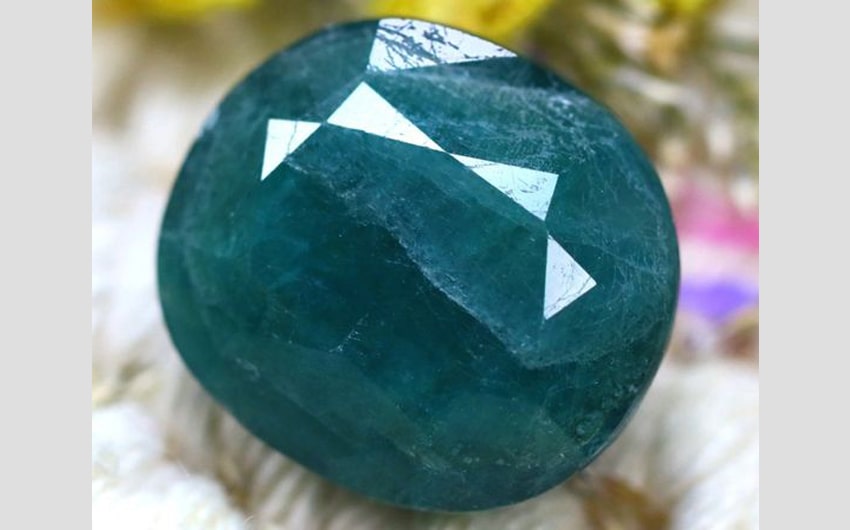
Image source: pinterest
Grandidierite is a rare mineral known for its stunning blue-green hue, making it one of the most beautiful and desirable gemstones in the world. Discovered in Madagascar in 1902 by French mineralogist Alfred Lacroix, Grandidierite was named in honor of the French explorer and naturalist Alfred Grandidier, who extensively studied Madagascar. While initially found in Madagascar, Grandidierite has since been discovered in a few other locations, but it remains one of the rarest gemstones on Earth.
What Makes Grandidierite So Rare?
The rarity of Grandidierite stems from both its limited geographic availability and the difficulty in finding gem-quality crystals. While Grandidierite can be found in Madagascar, Sri Lanka, and Namibia, gem-quality specimens with the desirable blue-green color are extremely rare. Most of the material discovered is opaque or only semi-transparent, and high-quality transparent stones are very difficult to come by.
The gem’s unique chemical composition, containing magnesium, aluminum, and boron, contributes to its distinct color and optical properties. The crystal structure of Grandidierite also causes strong pleochroism, meaning that the gemstone can display different colors when viewed from different angles—ranging from blue-green to yellowish-green to colorless.
Physical Characteristics of Grandidierite
Grandidierite is known for its striking blue-green color, which is its most prized feature. The gemstone exhibits strong pleochroism, meaning it can show different colors depending on the angle from which it is viewed. This property makes well-cut Grandidierite gems incredibly captivating.
The gem ranks 7.5 on the Mohs hardness scale, making it suitable for everyday jewelry wear. However, due to its rarity, Grandidierite is more commonly collected as a specimen rather than used in mainstream jewelry designs.
Value of Grandidierite
Grandidierite is one of the most valuable gemstones due to its rarity and the difficulty in finding high-quality transparent specimens. Transparent Grandidierite gems can fetch high prices, often exceeding several thousand dollars per carat, with prices rising as the gem’s color becomes more vivid and saturated. As one of the rarest gemstones in the world, Grandidierite is highly prized by collectors and investors alike.
Spiritual and Healing Properties
Grandidierite is thought to carry calming and balancing energy. Its soothing blue-green color is believed to help bring inner peace and enhance clear communication. In crystal healing, it is associated with the heart and throat chakras, promoting emotional healing and helping individuals express their true selves.
8. Taaffeite: A Rare and Misidentified Gemstone

Image source: pinterest
Taaffeite is an extremely rare gemstone, often confused with spinel due to their similar appearance. The gemstone was accidentally discovered in 1945 by gemologist Richard Taaffe, who found a gemstone in a jeweler’s collection that he initially thought was spinel. Upon closer inspection, it was found to be a completely new mineral, and thus, Taaffeite was born. Taaffeite’s rarity and brilliance have made it a highly sought-after gem, though its scarcity means that most people are unfamiliar with it.
What Makes Taaffeite So Rare?
Taaffeite is rare because it forms under very specific geological conditions, making high-quality specimens hard to come by. It is only found in a few locations worldwide, with Sri Lanka and Myanmar being the most significant sources of gem-quality Taaffeite. Additionally, it is often misidentified as spinel, which means that Taaffeite stones may go unnoticed unless subjected to detailed gemological analysis.
Its rarity, combined with its misidentification, makes it one of the world’s rarest and least-known gemstones.
Physical Characteristics of Taaffeite
Taaffeite can appear in various colors, from pale mauve and lilac to deeper purples, pinks, and reds. This range of colors, combined with its brilliance, makes Taaffeite highly desirable. It ranks 8 to 8.5 on the Mohs hardness scale, making it a durable gemstone for jewelry.
The gemstone is often found in small sizes, and larger, clean stones are extremely rare. When cut, Taaffeite can exhibit a striking brilliance, similar to spinel or sapphire, but its rarity gives it a unique allure.
Value of Taaffeite
Taaffeite is incredibly valuable due to its rarity, with prices ranging from several thousand to tens of thousands of dollars per carat, depending on the size, clarity, and color of the gem. Because of its rarity, Taaffeite is often only available to serious collectors or high-end jewelry designers.
Spiritual and Healing Properties
Taaffeite is believed to promote spiritual awareness and clarity of thought. Its gentle colors are said to encourage peace and calmness, and it is associated with the crown chakra, helping to connect individuals with higher consciousness and spiritual wisdom.
9. Phosphophyllite: A Rare and Fragile Crystal
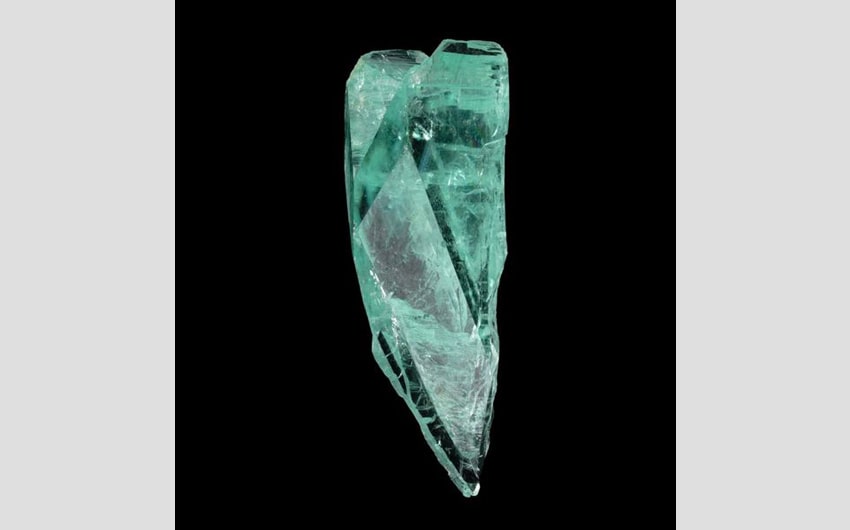
Image source: pinterest
Phosphophyllite is one of the rarest and most fragile minerals in the world, admired for its stunning blue-green color. It was first discovered in Bolivia, where most high-quality specimens are sourced. Its name is derived from its chemical composition, which includes phosphate, and its tendency to form leaf-like crystals (from the Greek word “phyllon,” meaning leaf). Due to its delicate nature and rarity, Phosphophyllite is highly prized by mineral collectors but is rarely seen in jewelry.
What Makes Phosphophyllite So Rare?
Phosphophyllite is rare because it forms under very specific conditions and is only found in a few locations, primarily in Bolivia. The gem’s fragile nature makes mining and cutting it extremely difficult, as it can easily break or fracture during extraction or handling. As a result, finding gem-quality Phosphophyllite is exceptionally challenging, and large, intact crystals are highly prized by collectors.
Due to its fragility, Phosphophyllite is not suitable for everyday wear in jewelry, further adding to its mystique as a collectible mineral rather than a gemstone.
Physical Characteristics of Phosphophyllite
Phosphophyllite is known for its beautiful blue-green hue, which can sometimes appear almost teal in color. The gem exhibits excellent transparency and a vitreous luster when cut and polished. However, its brittle nature, with a Mohs hardness rating of just 3 to 3.5, means that it is easily damaged, and only small, carefully handled specimens are typically available.
The gem’s striking color and transparency make it one of the most visually appealing rare minerals, but its softness limits its use in jewelry.
Value of Phosphophyllite
Due to its rarity and fragile nature, Phosphophyllite is one of the most valuable collector’s stones. Intact, high-quality specimens can fetch thousands of dollars, with larger, unblemished crystals being extremely rare and highly coveted by collectors.
Spiritual and Healing Properties
Phosphophyllite is believed to carry calming, balancing energy that promotes emotional healing and self-discovery. In crystal healing, it is associated with the heart and throat chakras, helping individuals communicate more effectively and open themselves up to love and compassion. Its beautiful blue-green color is thought to inspire clarity and inner peace.
10. Musgravite: One of the Rarest and Most Valuable Gems
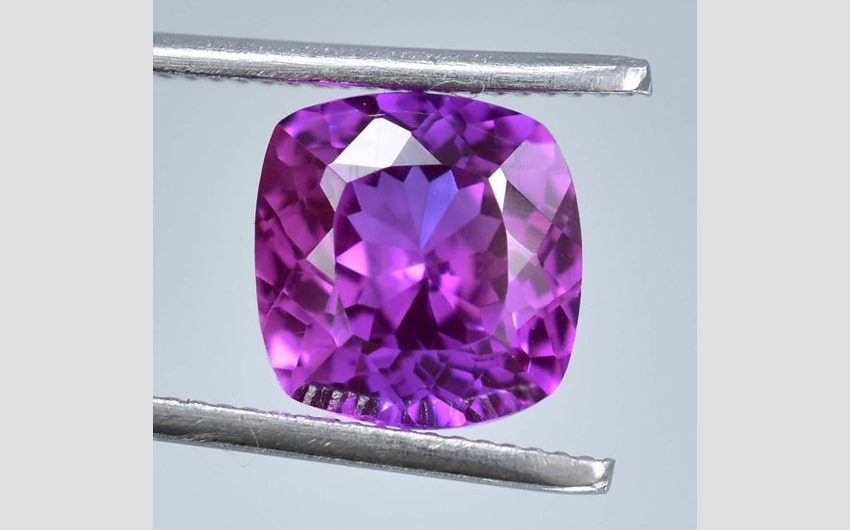
Image source: pinterest
Musgravite is one of the rarest and most valuable gemstones in the world, known for its grayish-violet hues and extreme scarcity. Discovered in 1967 in the Musgrave Ranges of South Australia (from which it gets its name), Musgravite was initially identified as a variety of Taaffeite until it was recognized as a separate mineral. Despite its discovery over half a century ago, Musgravite remains one of the most elusive gems in the world, making it a coveted stone for collectors and investors alike.
What Makes Musgravite So Rare?
Musgravite’s rarity stems from its limited geographical availability and the extreme difficulty in finding gem-quality specimens. The original discovery in Australia’s Musgrave Ranges has yielded only small quantities, and while deposits have since been found in other areas such as Greenland, Madagascar, Sri Lanka, and Tanzania, gem-quality Musgravite remains exceedingly rare.
In fact, until the late 1990s, only a few samples of Musgravite had been cut into faceted gems. Even today, only a handful of fine specimens are available, making it one of the rarest and most expensive gems in the world.
Physical Characteristics of Musgravite
Musgravite exhibits a range of colors, from grayish-purple to grayish-green or violet. It is often mistaken for Taaffeite, as the two minerals are chemically and structurally similar, but Musgravite is significantly rarer. On the Mohs hardness scale, Musgravite ranks 8 to 8.5, making it a durable gemstone suitable for jewelry.
The gem’s brilliance and color can vary depending on the cut, but well-cut Musgravite stones often display an attractive mix of metallic sheen and deep hues, particularly when viewed in different lighting conditions.
Value of Musgravite
Musgravite is one of the most valuable gemstones, with prices reaching up to $35,000 per carat or more, depending on the size, clarity, and color of the stone. Its extreme rarity, combined with its desirability as a gemstone, makes Musgravite a top-tier collector’s item. Large, gem-quality specimens are almost impossible to find, and even smaller stones are treasured by collectors worldwide.
Spiritual and Healing Properties
Musgravite is considered a powerful stone for transformation and spiritual growth. It is said to help those who work with it connect to higher states of consciousness, encouraging clarity of thought and deep inner reflection. The gem is also believed to promote patience and perseverance, making it ideal for individuals going through significant life changes or personal growth.
11. Larimar: The Beautiful Blue Gem from the Caribbean

Image source: pinterest
Larimar is a stunning blue gemstone found only in the Dominican Republic, making it a true treasure of the Caribbean. Its mesmerizing ocean-blue hues, reminiscent of the sea, have made Larimar highly popular in jewelry, especially among those seeking a connection to the calming energy of water. Discovered in 1974, Larimar has become a symbol of the Dominican Republic’s natural beauty, and its rarity and limited supply make it a sought-after stone among collectors and jewelry enthusiasts.
What Makes Larimar So Rare?
The rarity of Larimar comes from its highly specific geological formation and limited availability. Larimar is a variety of the mineral pectolite, which is usually gray or white. However, the unique volcanic activity in the Dominican Republic’s Bahoruco Mountain region caused Larimar to form with copper traces, giving it its distinctive blue color. This area is the only known source of gem-quality Larimar, and mining is done by hand, making extraction labor-intensive and slow.
Larimar’s blue color can range from light sky blue to deep volcanic blue, with some stones featuring white patterns or greenish hues, depending on the mineral content. The most desirable Larimar stones display vivid, oceanic blue tones, which are increasingly difficult to find as the mine’s supply dwindles.
Physical Characteristics of Larimar
Larimar is easily recognized by its beautiful blue color, often with white streaks or cloud-like patterns that resemble the sky or ocean. Its blue hues can vary in intensity, with darker blue shades being more valuable. The gemstone ranks 4.5 to 5 on the Mohs hardness scale, which means it is relatively soft compared to other gemstones and requires careful handling when used in jewelry.
Because of its softness, Larimar is most commonly found in cabochon cuts or polished into beads for necklaces, earrings, and bracelets. Its unique color and connection to the sea make it highly popular in artisan and bohemian-style jewelry.
Value of Larimar
While Larimar is more abundant than some of the world’s rarest gemstones, high-quality Larimar remains valuable, especially as supplies from the Dominican Republic begin to decrease. The price of Larimar varies depending on the color and quality, with deeper blue stones commanding higher prices. Larimar pieces are often used in handmade jewelry, adding artistic value to their natural beauty.
Spiritual and Healing Properties
Larimar is often associated with the calming, soothing energy of the sea. It is believed to promote inner peace, relaxation, and emotional healing. Crystal healers and spiritual practitioners use Larimar to connect with water energy, helping individuals release stress and connect with their inner tranquility. Larimar is also thought to enhance communication and encourage creativity, making it a popular stone for artists and those seeking emotional balance.
12. Serendibite: The Ultra-Rare Gem from Sri Lanka
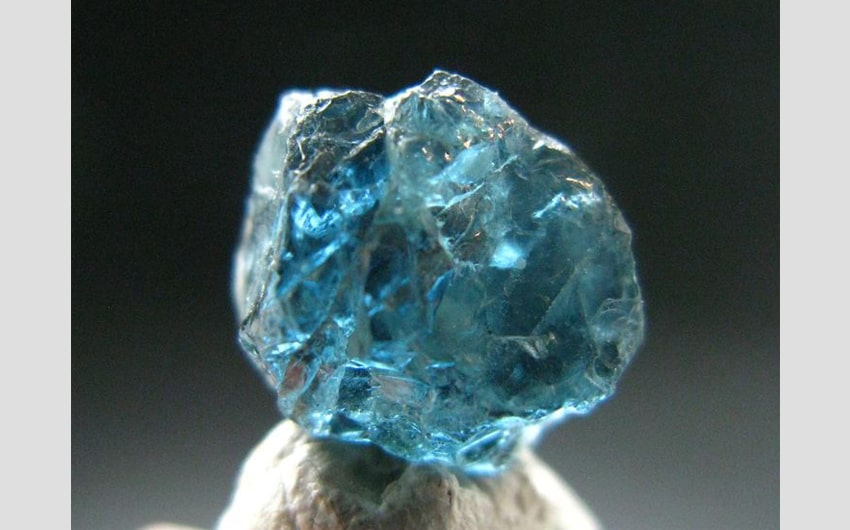
Image source: pinterest
Serendibite is one of the rarest gemstones in the world, known for its striking blue and green hues. Discovered in 1902 in Sri Lanka, Serendibite is named after the ancient name for Sri Lanka, “Serendib.” This ultra-rare gem is highly prized for its beauty and extreme scarcity, with only a handful of gem-quality Serendibite specimens ever found. In recent years, small deposits of Serendibite have also been discovered in Myanmar, but its overall rarity continues to make it one of the most valuable and sought-after gems among collectors.
What Makes Serendibite So Rare?
Serendibite is incredibly rare due to its limited geographical distribution and the challenging conditions under which it forms. The original discovery in Sri Lanka yielded only small quantities of gem-quality Serendibite, and later discoveries in Myanmar have produced only a few additional specimens. Serendibite’s chemical composition, containing magnesium, calcium, aluminum, silicon, and boron, makes it a complex mineral to form, adding to its rarity.
The deep blue-green variety of Serendibite is the most valuable, though the gemstone can also occur in black, dark green, and even pale blue. The combination of its rarity and striking color makes Serendibite one of the most expensive gemstones in the world.
Physical Characteristics of Serendibite
Serendibite can range in color from deep blue-green to black, depending on its specific chemical composition. The gemstone typically has excellent transparency and a vitreous luster when cut and polished. On the Mohs hardness scale, Serendibite ranks 6.5 to 7, making it relatively durable for use in jewelry, though its rarity often means it is kept as a collector’s stone rather than worn daily.
Gem-quality Serendibite is typically found in small sizes, with larger faceted stones being extremely rare. Even small Serendibite gems are highly valued due to the gemstone’s scarcity.
Value of Serendibite
Serendibite is one of the most expensive gemstones in the world, with prices reaching up to $2 million per carat for high-quality blue-green specimens. Its extreme rarity and unique color make it one of the most prized gems in the world of high-end collectors and gem enthusiasts. Even lower-quality Serendibite can command significant prices due to its scarcity.
Spiritual and Healing Properties
Serendibite is considered a stone of wisdom, intuition, and spiritual insight. Its deep blue-green color is thought to connect with the throat and third eye chakras, enhancing communication and inner vision. Crystal healers believe that Serendibite can help individuals gain clarity in difficult situations and foster a deeper connection to their intuition. It is also said to encourage balance, focus, and spiritual growth, making it a highly sought-after stone for meditation and spiritual practices.

